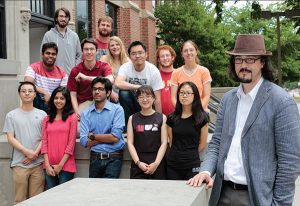
Advancing technology through practical and radical materials science
Materials science, chemistry, physics and life. These are the driving forces behind the research in Ludovico Cademartiri’s laboratory at Iowa State.
Cademartiri, assistant professor of materials science and engineering and associate scientist with the U.S. Department of Energy Ames Laboratory, says he and his graduate students work to go beyond understanding materials to exploring what’s happening at the edge of the discipline.
“The general approach of our lab is that we try to use our skills at making materials to answer fundamental questions, whether they are related to materials science, another discipline, or some space between,” Cademartiri explains.
The result is a good mix of interesting scientific problems, each with its own potential.
One project involves a big breakthrough but is also facing significant experimental challenges. The group wants to create a ceramic that behaves like a plastic. Combining the properties of these two classes of materials typically requires mixing them together in composites, which are difficult to process. No single material combines the properties of ceramics and plastics. Cademartiri says that while it’s considered fundamentally impossible, the group has evidence to the contrary.
“We’ve seen similarities between plastics and crystals when crystals are very thin, 50 thousand times thinner than a human hair. Plastics are composed of an entangled mess of thin strands, molecules specifically. These strands are very flexible in plastics, which allows them to behave the way they do. We have clear evidence that some extremely thin crystal strands are similarly flexible. Determining exactly how similar they are is important to apply these materials but is also extremely challenging.”
In another research program, the group has made significant headway in controlling microstructures in ceramics. The team has helped resolve an issue that had previously prevented making materials by selecting their individual components and then assembling and processing those components to create a material.
Cademartiri says in the past building a material from the bottom up has resulted in the material disintegrating during processing, making it hard to apply in devices. His team has found a new approach to avoid this issue entirely, thereby enabling an entirely new way of manufacturing materials with nearly complete control over their composition and structure. The findings will be published soon in two back-to-back articles in the journal Advanced Materials.
In a less traditional project, Cademartiri’s team has been working to use LEGO® bricks to simulate an ecosystem in the lab to study how plants interact with their environment. “We can control and understand pretty well a plant in isolation, but there’s so much more involved when you include the ecosystem wherein the plant exists,” he says. “If we can simulate this environment, and understand and predict how plants will respond to it, we should be able to improve the reliability of our food supply.”
While the group’s overall focus is to provide solutions for global problems (like improving food supply) and to resolve issues at the foundation of modern materials engineering (such as programming material properties, replacing extremely rare elements in materials, translating materials and processes from the lab to the outside world, and understanding what happens at the interface of two materials), Cademartiri says he encourages his team to think outside the box.
“Materials are, in most cases, the bottleneck in the development of new technology and new solutions,” he says. “Therefore, controlling materials or, in other words, knowing how to build things atom-by-atom, is one of the safest ways to have an impact on the world.”